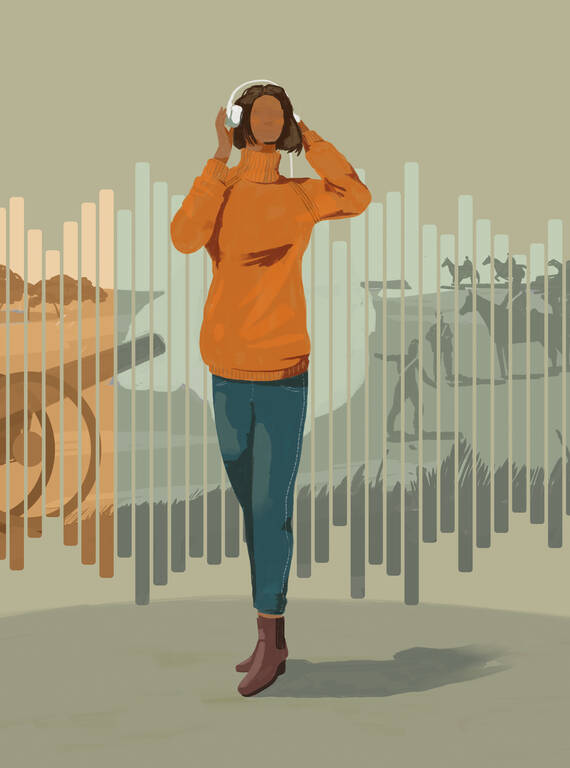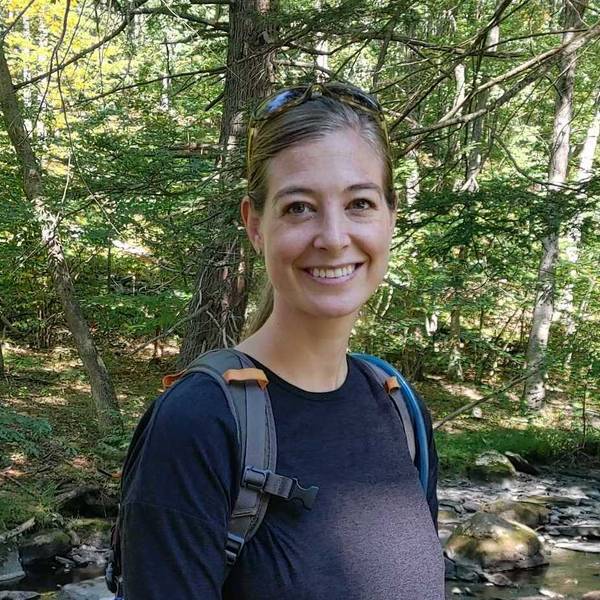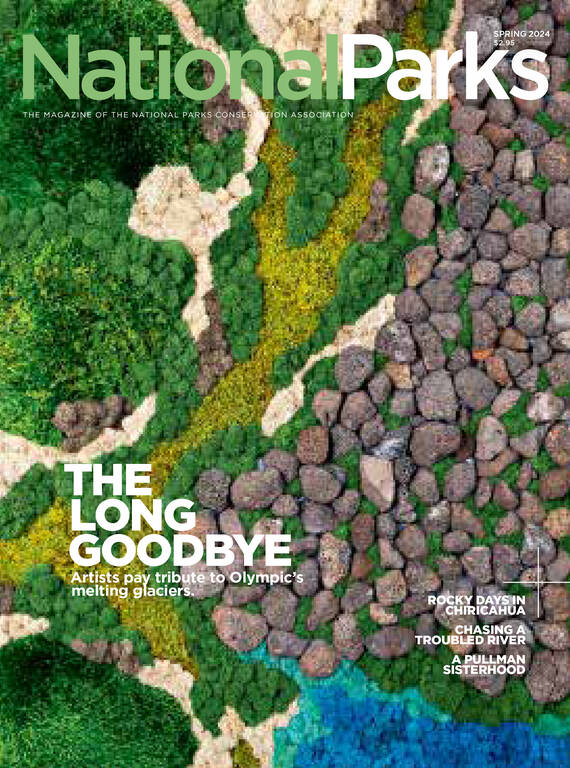Spring 2024
A Muted Morning
How one Civil War site is dialing back the noise — and light — to provide a more inclusive park experience.
A hush tends to settle over Gettysburg National Military Park in the winter months. By then, the busloads of students and caravans of history-loving vacationers have dwindled. Dipping temperatures and bitter winds also tend to curb the enthusiasm of day-trippers. In wintertime, it’s the truly hardy who venture out to the snow-frosted pastoral Pennsylvania landscape to learn about a Civil War battle where more than 50,000 men were killed, wounded, captured or pronounced missing.

On a recent Saturday morning, however, the park’s museum and visitor center were even quieter than usual. Small clusters of people wandered from display to display, whispering to their friends and loved ones. The lights were dim, and all visible screens — from the waist-high interactive stations to the overhead projectors to the wall-sized screens nestled in alcoves — were dark. No historical narration or bugle reveille filtered out of the mounted speakers. The contemplative atmosphere could have been the result of a technical glitch, but in fact, it was intentional.
Starting last year, park and Gettysburg Foundation staff have held occasional “sensory-friendly” hours, during which visitors who crave a pared-back experience can explore the museum and famous Cyclorama exhibit free of sounds — and free of charge. The effort is just one of many being piloted by the park’s small, but growing, education staff to make Gettysburg more welcoming to all. Barbara Sanders, the park’s supervisory education specialist, said her team frequently fields special requests, such as providing battlefield tours and programs using American Sign Language interpreters. These inquiries have underscored a need for more accessible offerings, so they developed a 75-minute virtual tour of the park for those who can’t visit in person and began hosting outreach events for people with limited vision or hearing. This year, they’re adding to the lineup with programs for English-language learners, using local college students as translators.

Growing up with Gettysburg
Over the decades, the park changed. So did I.
See more ›“It’s absolutely necessary for us to speak to ever-widening circles of visitors,” said Sanders, who has been at the park for 25 years. To succeed on this front, Sanders said, means thinking about the experience of first-time visitors and those who learn and experience the world differently. She knows Gettysburg, with its heavy subject matter, poses an even greater barrier to entry for the average visitor. “The history of it, the specifics of it, the gravity of it,” she said, “can be intimidating.” And while the Gettysburg grounds, complete with rolling hills, woods and monuments, can provide opportunities for quiet reflection, the museum isn’t set up for that. “There’s just too much going on,” Sanders said. “You can burn out quickly with all the stimulation. Any person can.”
Hence this winter’s sensory-friendly hours. Visitors with autism, post-traumatic stress disorder or attention-deficit/hyperactivity disorder — and their families and travel companions — are natural audiences for this kind of offering, but many other folks stand to benefit, too. Uma Srivastava, executive director of KultureCity, a nonprofit that focuses on sensory accessibility and inclusion, explained how anyone can experience changes and shifts in their senses throughout their life because of chemotherapy, epilepsy, stroke, illness or injury. “Often you don’t even need a diagnosis,” Srivastava said. Just look at how home-quarantining during COVID changed our comfort levels with crowds and public spaces, she said. “As we started going back into our typical environments — whether it’s concerts, restaurants — a lot of us were apprehensive,” she said. “A lot of us were anxious.“
Gettysburg is not the first venue to offer sensory-friendly activities. In 2011, Smithsonian museums in Washington, D.C., became some of the first to host events for neurodiverse audiences with their “Morning at the Museum.” Since then, countless other facilities have organized similar events. Over the last decade, KultureCity has certified more than 1,800 venues, from animal shelters to sporting arenas, as sensory inclusive. Initiatives like Gettysburg’s quiet hours, Srivastava said, help people see opportunity rather than impossibility when conceiving of a park visit. “Maybe they love that part of American history, but they’ve never really had the chance to go because they just didn’t know what the environment would be like,” she said. “It allows a family to say, ‘Hey, let’s plan a road trip,’” she said.
While welcoming new families to the park is a priority, Sanders knew over-advertising these particular events would be counterproductive. “It’s a sensory-friendly day,” she said. “You don’t want crowds and crowds of people.” And so, they alerted area schools and put out a couple of press releases but didn’t go overboard.

Gettysburg visitors take in the Cyclorama, a 140-year-old painting measuring 377 feet long and 42 feet high.
©WISKERKE/ALAMY STOCK PHOTODuring the visitor center’s quiet hours on Jan. 13, a pair of young boys excitedly questioned volunteer Tyrone Cornbower, who was staffing a “Hands on History” cart topped with sample cannon shells. Across the room, a family explored another cart draped in soldiers’ clothing. A sign encouraged visitors to touch and try on the pieces, and two of the children immediately began strapping on canteens and belts. In the museum, couples and small groups of friends chatted sotto voce while wandering from exhibit to exhibit. Inès de Cacqueray, who’d traveled from New York for the long weekend, was enjoying the dimly lit displays and the silent monitors. “The museum is so well set up,” de Cacqueray said. “I don’t feel like I’m missing anything.”
The only place with the occasional bottleneck was at the Cyclorama, French artist Paul Philippoteaux’s depiction of the pivotal third day of the 1863 Battle of Gettysburg. Even there, though, people calmly made way for one another as individuals and groups circled the interior of the 360-degree painting of Pickett’s Charge, pausing frequently to examine the horses and soldiers, fields and buildings that span the 377-foot-long and 42-foot-high work. Typically, the Cyclorama auditorium echoes with the sounds of rifle and cannon fire, designed to mimic the battlefield experience, while special lighting effects direct visitor attention to specific areas of the painting. While many people find value in the immersive display, others find it jarring. In an email, Christopher Gwinn, chief of interpretation and education at the park, went so far as to say the exhibit in its regular format “completely alienates” some visitors.

National Parks
You can read this and other stories about history, nature, culture, art, conservation, travel, science and more in National Parks magazine. Your tax-deductible membership donation of $25 or more entitles…
See more ›Those who showed up during this January’s quiet hours were free to simply marvel. Chris, a Pennsylvania native, was preparing to visit the painting with Eric, a fellow college student. (Both men declined to share their last names.) Chris, who is autistic, had seen the Cyclorama during previous visits to the park. “It can be a lot,” he said, before making an exploding gesture with his hand near his ear. He was looking forward to “just getting to view it all,” he said, without all the extra bells and whistles.
Most visitors, even those not aware of the sensory-friendly hours, appreciated the relaxed experience, but not everyone was a fan. One man said the museum felt “weird.” He and his family are members of the Gettysburg Foundation and regular visitors to the park. He admired the park for this initiative, but said, “I probably wouldn’t have come if I’d known.”
Luckily for him, at 11:05, as more families, a Boy Scout troop, and a woman in jogging gear arrived and prepared to enter the visitor center, a park staff member picked up a remote, pointed it at a TV and pressed the power button. Quiet hours — at least for that day — had officially ended.
About the author
-
 Katherine DeGroff Associate and Online Editor
Katherine DeGroff Associate and Online EditorKatherine is the associate editor of National Parks magazine. Before joining NPCA, Katherine monitored easements at land trusts in Virginia and New Mexico, encouraged bear-aware behavior at Grand Teton National Park, and served as a naturalist for a small environmental education organization in the heart of the Colorado Rockies.

